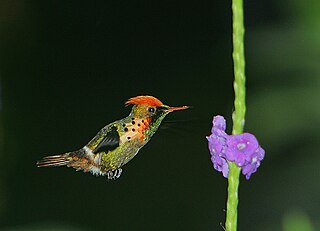
The tufted coquette is a tiny hummingbird that breeds in eastern Venezuela, Trinidad, Guiana, and northern Brazil. It is an uncommon but widespread species, and appears to be a local or seasonal migrant, although its movements are not well understood.
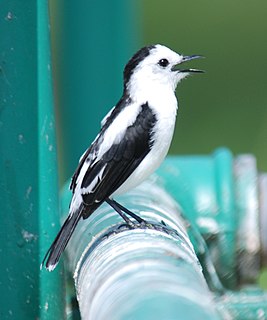
The pied water tyrant is a small passerine bird in the tyrant flycatcher family. It breeds in tropical South America from Panama and Trinidad south to Bolivia.

The Brazilian ruby is a species of hummingbird found in forest edge, second growth, gardens and parks in eastern Brazil. It is the only species placed in the genus Clytolaema. It is common and among the species regularly seen at hummingbird feeders within its range. It is a relatively large hummingbird. The male is overall green with a coppery back and rump, a coppery-rufous tail and, as suggested by its common name, a highly iridescent ruby throat that can appear black from some angles. Females are green above and cinnamon below. Both sexes have a white post-ocular spot and a straight black bill.
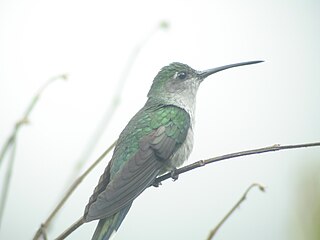
The grey-breasted sabrewing is a species of hummingbird in the family Trochilidae.

The black nunbird is a species of bird in the family Bucconidae, the puffbirds. It is found in north-central South America in the Guianas of Guyana, Suriname and French Guiana including the Guiana Shield; also eastern and southeastern Venezuela in the eastern Orinoco River Basin, and the Amazon Basin of northeast Brazil in the north-central and northeast. It is not found south of the Amazon River, and its western limit bordering southeast Venezuela is the Rio Negro.

The pied puffbird is a species of puffbird in the family Bucconidae.

The rufous nightjar is a species of nightjar in the family Caprimulgidae.
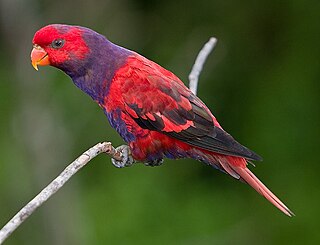
The violet-necked lory is a species of parrot in the family Psittaculidae. It is endemic to Indonesia, where it is found in the northern Maluku Islands and west Papuan islands. Its natural habitats are tropical moist lowland forests and tropical mangrove forests.

The lilac-tailed parrotlet is a species of parrot in the family Psittacidae. It is found in Colombia, French Guiana, Guyana, Suriname, Trinidad and Tobago, and Venezuela. Its natural habitats are subtropical or tropical moist lowland forest and subtropical or tropical moist montane forest.

The spotted rail is a species of bird in the family Rallidae. It is found in Argentina, Belize, Bolivia, Brazil, Cayman Islands, Chile, Colombia, Costa Rica, Cuba, the Dominican Republic, Ecuador, El Salvador, French Guiana, Guyana, Jamaica, Mexico, Panama, Paraguay, Peru, Suriname, Trinidad and Tobago, Uruguay, Venezuela, and possibly Honduras. The spotted rail is found in marshland and swamps.

The rufous-throated antbird is a species of bird in the family Thamnophilidae. It is found in Brazil, French Guiana, Guyana, Suriname, and Venezuela. Its natural habitat is subtropical or tropical moist lowland forests.
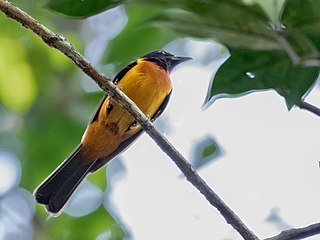
The fulvous shrike-tanager is a South American bird in the tanager family Thraupidae. It is found in Brazil, Colombia, Ecuador, French Guiana, Guyana, Peru, Suriname, and Venezuela. Its natural habitat is subtropical or tropical moist lowland forests.

The helmeted pygmy tyrant is a species of bird in the family Tyrannidae. It is found in Brazil, Colombia, French Guiana, Guyana, Peru, Suriname, and Venezuela. Its natural habitats are subtropical or tropical moist lowland forests and heavily degraded former forest.

The wing-banded antbird is a species of passerine bird in the antbird family, Thamnophilidae. It is placed in the monotypic genus Myrmornis. It is found in Brazil, Colombia, Ecuador, French Guiana, Guyana, Nicaragua, Panama, Peru, Suriname, and Venezuela. Its natural habitat is subtropical or tropical moist lowland forests.

The cinereous becard is a species of bird in the family Tityridae. The term cinereous describes its colouration. It has traditionally been placed in Cotingidae or Tyrannidae, but evidence strongly suggest it is better placed in Tityridae, where it is now placed by the South American Classification Committee.

The red-necked woodpecker is a species of bird in the family Picidae. It is found in Bolivia, Brazil, Colombia, Ecuador, French Guiana, Guyana, Peru, Suriname, and Venezuela. Its natural habitats are subtropical or tropical moist lowland forest and subtropical or tropical moist montane forest.

The spot-breasted woodpecker is a species of bird in the family Picidae. It is found in South America in Bolivia, Brazil, Colombia, Ecuador, French Guiana, Peru, Suriname and Venezuela and also in eastern Panama of Central America. Its natural habitats are subtropical or tropical moist lowland forests, subtropical or tropical mangrove forests and heavily degraded former forest.

The olive woodpecker is a species of bird in the woodpecker family Picidae.

The white-bellied seedsnipe is a species of bird in the Thinocoridae family.
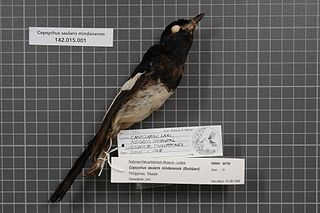
The Philippine magpie-robin is a species of bird in the family Muscicapidae. It is endemic to the Philippines. It used to be considered a subspecies of the Oriental magpie-robin.





















